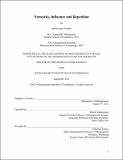Networks, Influence and Repetition
Author(s)
Sassine, Jad Georges
DownloadThesis PDF (4.156Mb)
Advisor
Rahmandad, Hazhir
Terms of use
Metadata
Show full item recordAbstract
The diffusion of beliefs and behaviors is shaped by the network in which people are embedded. Our focus is on the context of complex diffusion where multiple interactions and reinforcements may be needed for adoption of an idea, action, process, or product. A powerful intuition informs current thinking on the topic: clustered networks provide the repeated reinforcement needed for complex contagion. Thus, current theory makes a sharp distinction between simple and complex contagion, where the former benefits from random bridges to distant parts of the network, but complex contagion is more efficient on densely clustered networks.
The first paper uses analytical arguments and extensive simulations to challenge this common intuition. We show that when there is some stochasticity in choice, random links are more valuable than previously acknowledged, even in the context of complex diffusion; and that the repetition of messages by the same adopter can significantly strengthen the advantages of random (vs. clustered) networks. The second paper investigates the role of repeated reinforcements empirically. We build a simple model to quantify the effect of repetition through the lens of limited memory, and parameterize this model using data from an online experiment where participants need to estimate the opinion of their friends.
The third paper explores social reinforcement through a different lens: within-category spillovers during category emergence. Categories are defined by within substitution effects: increasing the utility of one product decreases that of the others. However, in situations for which the category has yet to gain acceptance, understandings, and legitimacy, increasing the utility of one product may increase familiarity with other products, leading to positive spillover effects. We analyze these effects during the emergence of hybrid electric vehicles, leveraging an incentive that affected a subset of vehicles, providing a natural exclusion restriction.
Date issued
2021-09Department
Sloan School of ManagementPublisher
Massachusetts Institute of Technology